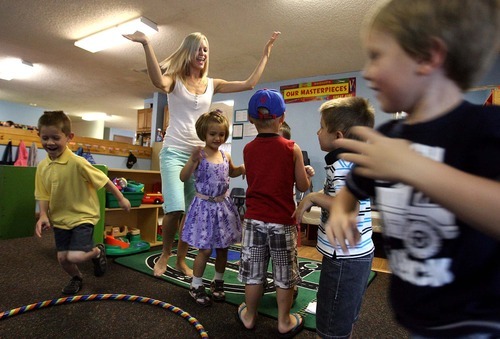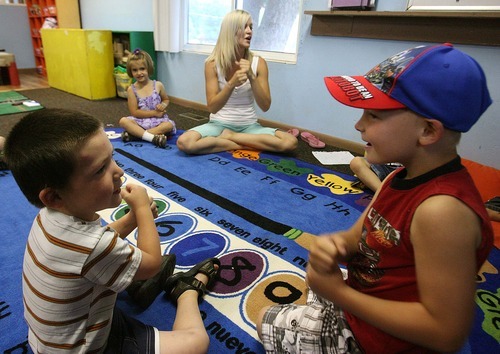This is an archived article that was published on sltrib.com in 2011, and information in the article may be outdated. It is provided only for personal research purposes and may not be reprinted.
When the kids at Progressive Preschool and Child Care Center in South Ogden jump in the air and shout "ribbit," they're not just fooling around. Pretending to be a frog gets them moving — and helps the state combat obesity.
By some measures, Utah is doing better than most — ranking as the sixth least obese state, according to a report released Thursday by the Trust for America's Health. Among the state's adults, 23.4 percent are considered obese.
But Utah's ranking doesn't mean state health leaders are satisfied.
"The obesity rate is not going down in Utah," said Lynda Blades, program manager of the Physical Activity, Nutrition and Obesity program at the Utah Department of Health. "It just means we're one of the healthiest states, but when you look at the trends we still have a long ways to go."
Fifteen years ago, the state's obesity rate stood at 12 percent, a number that has increased by more than 90 percent.
With too much weight comes a variety of health challenges, including diabetes and high blood pressure, both of which are on the rise in Utah.
No state saw its adult obesity rate decline, the report says. Utah's grew slightly, up from 23.2 percent in 2010. At 34.4 percent, Mississippi had the worst rate.
As in many states, Utah's minority population struggles with a higher obesity rate. At 37.1 percent, blacks had the highest percentage of obese members, compared to the white population at 23 percent. Latinos have a slightly higher rate at 27.4 percent.
Overall, Utah's men are typically more obese than women, with 25.3 percent extremely overweight compared to 21.3 percent of women.
Trust for America's Health points to efforts in some states to reduce obesity, particularly regarding children. However, it notes that Utah does not yet have a body mass index screening program or a farm to school food program.
But a Utah child-care center initiative, which includes Progressive Preschool, is aimed toward helping children lead healthier lives through more activity and better food choices. Three health departments — Weber-Morgan, Davis County and Tooele County — are working with 21 centers during the yearlong program.
In Utah, 21 percent of elementary-age students are overweight or obese, a statistic that pushed health leaders to focus on the state's youngest.
Along with playing "ribbit," the kids at Progressive Preschool are getting more active in their music class, a time that used to mean only listening. These days, the children are dancing like raindrops and swaying like flowers. They're walking to parks and the fire station for field trips. They're eating healthier without even knowing it.
"We've snuck vegetables in our foods such as shredded zucchini in lasagna," said director Jamie Dobson. "It's amazing how a 1-year-old looks at a tomato and goes, 'Nope.' "
Experts say obesity can affect life expectancy despite many of the health improvements made over past decades. For some groups, such as women in parts of the Southeast, life expectancy is already on the decline.
Eric Reither, a Utah State University sociologist who focuses on the effects of obesity, says research needs to change to take the epidemic into account.
"Traditional projection methods look to the past and assume that improvements in the health and longevity of older Americans will be replicated and even improved upon in the future," Reither said in a statement. "What we're finding is that isn't the case with the current obesity epidemic. We need to think of the health of today's kids and adapt modeling so that it is sensitized to their health if we're going to make accurate predictions about the future."
How does Utah compare?
The state ranks sixth best in the nation for its obesity rate, though its percentage of obese adults — 23.4 percent — has grown since 2010. To read the report, go to: http://www.healthyamericans.org.







